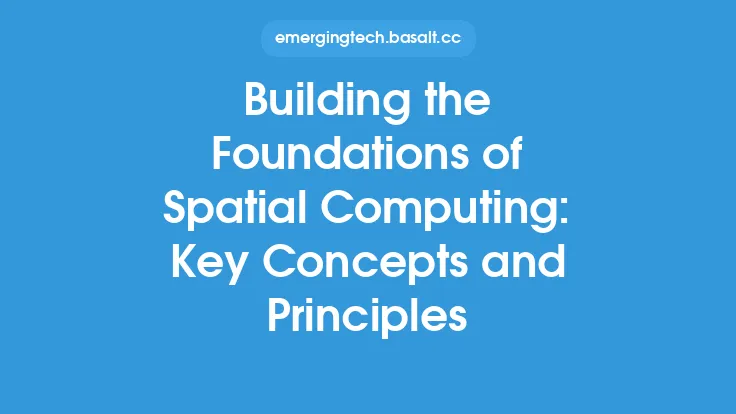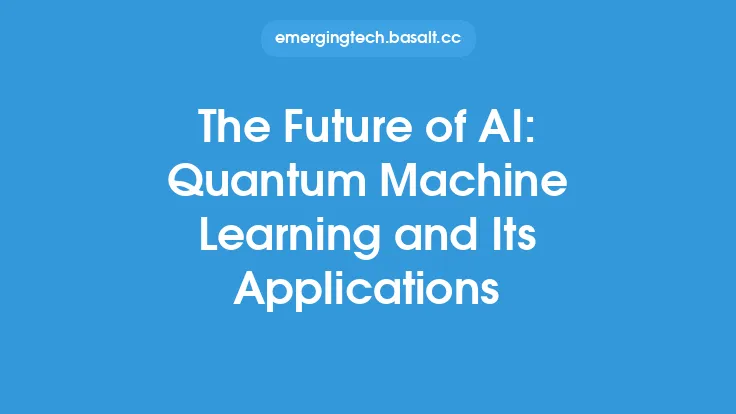The concept of spatial computing has been gaining significant attention in recent years, and its potential to revolutionize various industries and applications is vast. At its core, spatial computing refers to the ability of computers to understand and interact with the physical world in a more human-like way. This is achieved through the use of sensors, cameras, and other technologies that allow computers to perceive and interpret their surroundings. By leveraging spatial computing, industries such as healthcare, education, and entertainment can create more immersive and interactive experiences, leading to increased engagement and improved outcomes.
Introduction to Spatial Computing
Spatial computing is a multidisciplinary field that combines computer science, engineering, and design to create interactive and immersive experiences. It involves the use of various technologies, including augmented reality (AR), virtual reality (VR), and the Internet of Things (IoT), to create a more seamless and natural interaction between humans and computers. Spatial computing has the potential to transform the way we live, work, and interact with each other, and its applications are vast and varied. From enhancing healthcare outcomes to revolutionizing the entertainment industry, spatial computing is poised to have a significant impact on various aspects of our lives.
Applications of Spatial Computing
One of the most significant applications of spatial computing is in the field of healthcare. By using spatial computing, healthcare professionals can create more immersive and interactive training simulations, leading to improved skills and better patient outcomes. For example, surgeons can use spatial computing to practice complex procedures in a virtual environment, reducing the risk of errors and improving patient safety. Additionally, spatial computing can be used to create personalized treatment plans, taking into account a patient's unique anatomy and medical history. This can lead to more effective treatment and improved patient outcomes.
Spatial Computing in Education
Spatial computing also has the potential to revolutionize the education sector. By creating interactive and immersive learning experiences, students can engage more deeply with complex concepts and ideas, leading to improved understanding and retention. For example, students can use spatial computing to explore virtual labs, conduct experiments, and interact with complex systems in a safe and controlled environment. This can lead to a more engaging and effective learning experience, and can help to improve student outcomes. Additionally, spatial computing can be used to create personalized learning plans, taking into account a student's unique learning style and abilities.
Spatial Computing in Entertainment
The entertainment industry is another area where spatial computing has the potential to make a significant impact. By creating immersive and interactive experiences, entertainment companies can engage audiences in new and innovative ways, leading to increased engagement and loyalty. For example, spatial computing can be used to create interactive movies and games, where the audience can influence the storyline and interact with the characters. This can lead to a more immersive and engaging experience, and can help to create a new generation of entertainment products.
Technical Aspects of Spatial Computing
From a technical perspective, spatial computing involves the use of various technologies, including sensors, cameras, and display systems. These technologies allow computers to perceive and interpret their surroundings, and to create interactive and immersive experiences. For example, spatial computing can use computer vision and machine learning algorithms to track the movement of objects and people, and to create a 3D model of the environment. This can be used to create interactive and immersive experiences, such as augmented reality and virtual reality.
Challenges and Limitations
Despite the potential of spatial computing, there are several challenges and limitations that need to be addressed. One of the main challenges is the need for more advanced and sophisticated technologies, such as sensors and display systems. Additionally, spatial computing requires significant computational power and data storage, which can be a challenge in terms of cost and scalability. Furthermore, spatial computing raises several ethical and social concerns, such as privacy and security, which need to be addressed through the development of robust policies and regulations.
Future Directions
In terms of future directions, spatial computing is likely to continue to evolve and improve, with the development of more advanced and sophisticated technologies. For example, the use of artificial intelligence and machine learning algorithms is likely to become more prevalent, allowing for more complex and interactive experiences. Additionally, the development of new display systems, such as augmented reality glasses and virtual reality headsets, is likely to continue to improve the immersive and interactive nature of spatial computing experiences. As spatial computing continues to evolve, it is likely to have a significant impact on various aspects of our lives, from healthcare and education to entertainment and beyond.
Conclusion
In conclusion, spatial computing has the potential to revolutionize various industries and applications, from healthcare and education to entertainment and beyond. By leveraging spatial computing, industries can create more immersive and interactive experiences, leading to increased engagement and improved outcomes. While there are several challenges and limitations that need to be addressed, the future of spatial computing is likely to be shaped by the development of more advanced and sophisticated technologies, and by the need for more robust policies and regulations. As spatial computing continues to evolve, it is likely to have a significant impact on various aspects of our lives, and is an area that is worth watching in the coming years.





